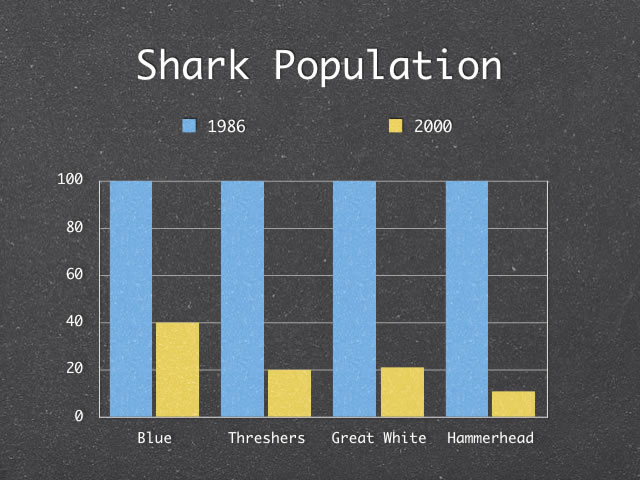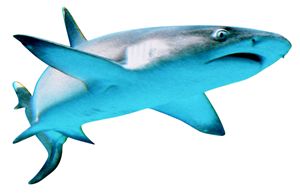The following article is a revealing example of the development of a preliminary multimedia design document based on an existing newspaper article. By deconstructing the source article into its most essential content it is much easier to see how it can be enhanced with the addition of supportive media and interactivity. The process shown is by no means the best way to approach the design of a multimedia program, but it shows one approach to the finessing of ideas and resource materials to form a more usable multimedia product.
Step 1: Determine the Topic and Source Research Material for the Program
Decide on a topic and locate an article, web site, or other appropriate source for the core content of the multimedia program. In this example the topic is "Sharks." This is, of course, much too vague a topic, but it will be the starting point. Research of the topic is critical at this point because the results of the research will greatly effect the nature of the program.
Step 2: Distill the Most Significant Facts
Using the "Google" search engine and looking at the top 10 hits an article focusing on how Sharks are misunderstood is located.
The full article that will be the basis of the program is shown below:
Aquarium Says Sharks Are Misunderstood
BALTIMORE (AP) - Visitors to a shark exhibit at the National Aquarium can leave any thoughts of "Jaws" at the door.
Curators hope to dispel myths about the misunderstood and threatened creatures by allowing visitors to touch young sharks, watch shark eggs develop and gaze at a dozen species gracefully prowling a 260,000 gallon tank.
A national survey sponsored by the museum ahead of the exhibit found that people had some serious misconceptions about sharks. More than 80 percent of the 1,010 adults polled said shark populations are "just right'' or "too high.'' The poll had a margin of error of plus or minus two percentage points.
"The message we want you to leave with is that of conservation of sharks,'' said Nancy Hotchkiss, developer for the Shark Quest exhibit which runs through December.
"If people considered them about the same way they do dolphins and whales that would be phenomenal,'' Hotchkiss added.
The message underlined in the exhibit is that many species are threatened - more than 11,400 sharks are killed every hour every day. Although sharks are not considered endangered by the U.S. government, some regions have put in place protections for dwindling species.
The show comes on the heels of an important study on the subject entitled "Collapse and Conservation of Shark Populations in the Northwest Atlantic,'' released in January.
The Dalhousie University study, published Jan. 17 in the journal Science, found that almost all recorded shark species have declined by half in the past eight to 15 years.
Researchers looking at fishing fleet logbooks from 1986 to 2000 found that hammerhead shark populations were down 89 percent in the Atlantic, tiger sharks were reduced by 65 percent, blue sharks 60 percent, threshers 80 percent and great white sharks - made infamous by the movie "Jaws'' - have declined by 79 percent.
"It has been difficult to judge as a global trend as some species that may be OK in one part of the world, the same species could be in decline in another region,'' said Jenny Fiegl, an animal educator at the aquarium.
Although sharks in Asia are sought after for such delicacies as shark fin soup, in the Atlantic, shark populations fall prey to bycatching, where fishermen hunting tuna and swordfish inadvertently catch sharks.
"Some fishing processes are actually strip mining the ocean,'' said Dave Schofield, the manager of the aquarium's ocean health program. "They throw them away like trash. If they aren't already dead from exposure, the ones that swim away are severely stressed and die soon after.''
The aquarium survey also found a number of other misconceptions.
More than 70 percent of those polled said they believed sharks are dangerous, when in reality 94 percent of the 400 species of sharks are harmless to humans.
Shark attacks are extremely rare. People are more likely to be injured by a hamster or killed by lightning than by a shark.
To emphasize this the museum set up a touching pool where children can watch Whitespotted Bamboo sharks develop inside their egg sacks and pet the sharks' older brothers and sisters in an adjoining tank.
Fiegl said the hardy sharks, which have been prepped for months to be touched, will not be harmed by the attention.
"People fear what they don't know,'' said Hotchkiss. "Sharks have been around for 400 million years and play a critical role in ocean health. We want people to discover that sharks are amazing animals that deserve our respect and need our protection.''
Design Elements
Focusing the topic and establishing what the goal of the program will be is critical, as is the intended audience.
After briefly researching the topic I have determined that the goal is to inform a general audience that sharks are not the "monsters" that they are often portrayed to be.
The "general audience" are young to adult English speaking, web-savvy people who may have an inclination to be interested in environmental issues, biology, or ecology. The basic format of the program will be material that can be viewed or explored with a web browser. Shockwave is the most likely format for the interactive portions of the program, but HTML may be enough for the delivery of most of it.
The extent of development for the topic is yet to be determined, but "simpler" is probably the best choice. The presentation should be concise, yet interesting.
Step 3: Organize the Facts
Working Title - Sharks: More Than Jaws
Version 1.0a Monday, April 14 - 2003
Main Issues
- Shark Species are Threatened
- Shark Populations Have Declined
- Sharks are Misunderstood
- Sharks are not necessarily bad
Shark Species are Threatened
- More than 11,400 sharks are killed every hour every day
- Almost all recorded shark species have declined by half in the past eight to 15 years
- From 1986 to 2000 found that hammerhead shark populations were down 89 percent in the Atlantic
- Blue sharks 60 percent decline
- Threshers 80 percent decline
- Great white sharks declined by 79 percent.
Some Reasons why Shark Populations Have Declined
- Asia – Shark Fin Soup
- Tuna and Swordfish “bycatching”
- "Some fishing processes are actually strip mining the ocean,'' said Dave Schofield, the manager of the aquarium's ocean health program. "They throw them away like trash. If they aren't already dead from exposure, the ones that swim away are severely stressed and die soon after.''
Misconceptions About Sharks
- More than 70 percent of those polled said they believed sharks are dangerous, when in reality 94 percent of the 400 species of sharks are harmless to humans.
- Shark attacks are extremely rare. People are more likely to be injured by a hamster or killed by lightning than by a shark.
- Improving Shark Popularity
- Touching pool where kids can touch sharks and see eggs. "People fear what they don't know,'' said Hotchkiss. "Sharks have been around for 400 million years and play a critical role in ocean health. We want people to discover that sharks are amazing animals that deserve our respect and need our protection.''
Part of the process of examining the facts is choosing which facts are the most interesting, memorable, or supportive of the topic's goal. Fortunately, there are plenty of juicy factual tidbits to work with, just from this article.
Step 4: Determine Treatment and Format
I've decided that I want people to empathize with sharks, in a sense. Part of the goal is to help them see how fragile sharks really are and how the worldwide shark population is declining drastically. I have made a graph, based on the facts of the article to emphasize the decline in shark population. I will try to use this in the program to help people understand how much shark populations have been reduced recently.

If possible, I think it would be fun to have some kind of interactive game with sharks swimming around to accompany some of the material. The game should help make people more comfortable with sharks and appreciate their importance in the ecosystem. This idea will have to be further worked with, but it would help make the whole program more effective.
Generally, I will consider a slideshow style presentation for part of the content, but narration, sound effects, and music will also be considered. With narration it can be something like a mini documentary, but there will be an area at the bottom of the screen that will support each point made with text. The amount of text shown at once will be carefully determined to make the program easier to follow and more engaging for the audience.
Step 5: Locate Supportive Materials



This is only a starting point for images. The idea is to locate pictures and media resources that are interesting to look at and, if possible, "dramatic." These images were found by using the Google "Images" search engine.
Other Shark Links for Research and Content:
http://www.pbs.org/wgbh/nova/sharks/world/
http://marinesource.com/boats/hawaii_sharks.html
http://www.marinelab.sarasota.fl.us/~rhueter/sharks/myths.phtml#mythm
Step 6: Begin Mockups and Storyboards
The background research and supportive material should be completely established before the script, storyboard, or frame map documents are created. Assuming the background research is sufficiently developed it's time to try out a few themes and ideas.
Title
Shark swims back and forth. Silly "Jaws" music plays. Hitting any key or clicking the mouse jumps to the "Main" screen. After 1 minute of no activity, the program auto-advances to "Main."
Main Sharks Screen
Main
All buttons and rollovers have a highlighted effect. "Home" always goes to this screen. Clicking the shark image goes to the "Title" screen.
Sharks Aren's So Bad
Sharks Aren't So Bad
Movie has a standard QuickTime controller.
Endangered Shark Species
Endangered Shark Species
Sharks have simple animation when rolled over.
Shark Species
Shark Species
Shark species name appears when shark is rolled over.
Multimedia Shark Screen
Video Audio Text Screen
Voiceover narration of the text is optional.
Shark Videos
Shark Videos
Home goes to the "main" screen. "Back" and "Next" advance through the available videos.
Shark Articles
Shark Articles
When the article title is clicked the story screen pops up.
Shark Article Example
A Single Shark Article Article layout example.
Declining Sharks
Shark Graph
Other charts and graphs may be added here.
Alternative Shark Species Layout
Alternative Shark Species
Alternative shark species layout.
Other Program Specifications
The first draft design assumes this will be developed for a CD-ROM or DVD format. The screen size will be 800 x 600, though this may become 720 x 480 if a DVD version is produced.
The intended audience is English speaking adults, though other languages could be added to the content. The content is likely suitable for children, though some of the videos might need to be removed because of graphic content.
All articles will have a voiceover option, which will allow the user to hear any text article read aloud, if desired. When a movie or sound are playing any change of movie or sound will stop any currently playing media. Audio will fade out when switching from one source to another. Video content will immediately switch, and as any video is activated, all previously playing audio will be silenced.
A credits screen will need to be added.
Note: You may download an Adobe Fireworks PNG source file of the above design images here, or a JPEG version of the images here.
Navigation and Link Map
